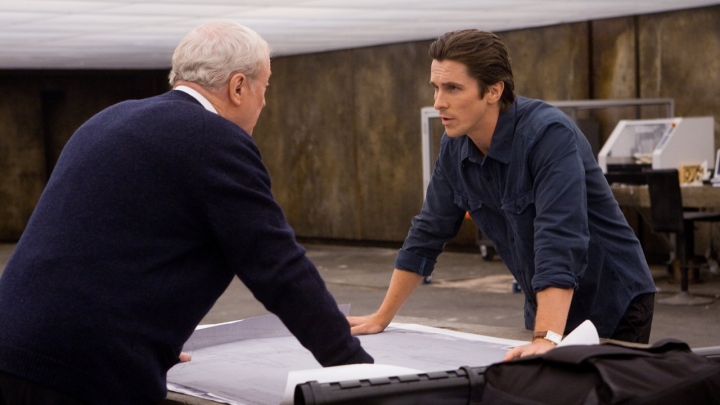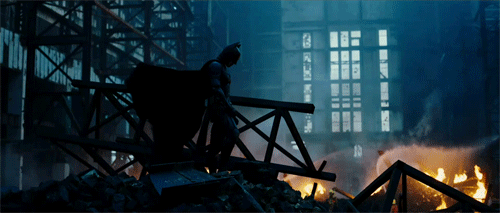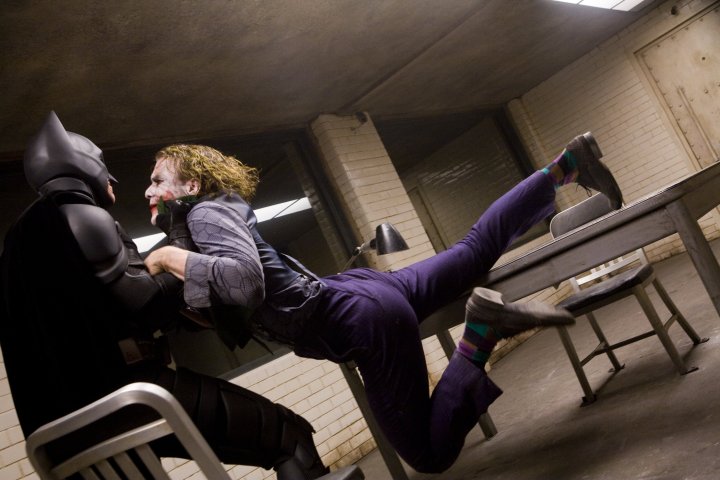The first impression we have of Batman in The Dark Knight comes not by actually seeing Batman, but by hearing what people think about him. A dealer on the street refuses to make a deal because he sees the batsignal in the sky. A mob leader brings a pack of dogs and armed men with him to make a simple drug trade. A group of renegade “copycats” tries to bring justice to the streets by imitating Batman’s work. This all goes to show that in a span of one year, Batman has already become a symbol. As a Gotham citizen said in his final moments, Batman is “a symbol that we don’t have to be afraid of scum like [the Joker]” (Thomas & Nolan 2008). The first impression of Bruce on the other hand is a man dedicated to his mission. He is fully immersed in his work as the Batman, and the rest of his life is a mere façade. Nearly everything he does, even as Bruce Wayne, is to further his quest for justice in Gotham.
The inciting incident in The Dark Knight occurs after the Joker kills a citizen, and gives Batman an ultimatum: “Batman must take off his mask and turn himself in…and every day he doesn’t, people will die” (Thomas & Nolan 2008). This prompts Batman into action, putting all his skills, time, and resources into locating and apprehending the Joker. Bruce’s personal goal in The Dark Knight is to be able to “retire” as Batman and lead a normal life with Rachel. The city’s corruption is slowly leaving and city officials have started taking a stand against crime; he sees this as a sign that Batman may no longer be needed.
Dialogue
Throughout the film, Batman continues to speak with his muffled, guttural voice, while Bruce Wayne continues to speak of his distaste for the Batman. Bruce is a man of few words in this film. He seems worn down, tired, and pensive, and he often chooses to reflect on his actions rather than speak. When he does speak, his fatigue and his sadness for Gotham’s situation shows through his words. Batman does maintain some sense of humor in the film. After an impersonator asks him “what’s the difference between you and me?” Batman quips, “I’m not wearing hockey pads” (Thomas & Nolan 2008). Despite the occasional one-liner, Batman is at his darkest in this film, leaving the humor and lighthearted moments to other characters. The conflict in all three films is grave, but this film is perhaps the most personal to him, as the Joker attempts to unmask him, threatening (and even killing) some of his closest confidants. This leaves Bruce/Batman with very little chance for humor or small talk.
Relationships
Bruce Wayne/Batman’s relationships in the film are a driving factor behind much of the film’s plot. The Joker continuously takes advantage of Batman’s weaknesses by threatening his closest friends and confidantes. Bruce is slightly more withdrawn from Rachel than in Batman Begins, likely because of her relationship with Harvey Dent. However, he still loves her, and sees her as his “one hope for a normal life” (Thomas & Nolan 2008). He shares a passionate kiss with her in the film, in hopes that they can still be together one day, but Rachel seems to know that this can never happen. She still feels deeply for Bruce, but her love for Harvey has grown stronger. She says she’ll always be there for Bruce, “but as [his] friend,” nothing more (Thomas & Nolan 2008).

Bruce also follows the guidance of Alfred and Lucius Fox, taking their advice to heart in tough situations and looking to them for moral guidance. Batman and Gordon have clearly established a more trusting relationship since the end of Batman Begins; each is comfortable with the role that the other plays in solving crime. Harvey Dent is curious about Batman’s involvement in stopping crime, but he realizes that Batman truly wants to help Gotham City.
Decisions
Batman’s choices affect the plot in consequential ways. He chooses not to turn himself in, which results in the deaths of many citizens, but ultimately allows him to defeat the Joker. He chooses not to kill the Joker, which leads to more and more chaos as the film progresses. He chooses to attempt to save Rachel, which results in saving Harvey (thanks to the Joker’s scheme), but eventually results in Harvey’s downfall. At the film’s conclusion, he takes the blame for Harvey’s murders, which results in peace and order in Gotham for 8 years – but it is all built on a lie.

The Joker cannot help but gloat about Batman’s decisions and how they affected the citizens of Gotham.
“I wanted to see what you’d do,” he says, “And you didn’t disappoint…you let five people die. Then you let Dent take your place. Even to a guy like me… that’s cold” (Thomas & Nolan 2008).
Alfred assures Bruce that even if his choices were immoral, they were the wisest choices to make. “Endure, Master Wayne. Take it. They’ll hate you for it, but that’s the point of Batman…he can be the outcast. He can make the choice no one else can face. The right choice” (Thomas & Nolan 2008).
In the end, Gotham does hate Batman for his decisions, an unusual outcome for the hero of a film. Look at other superhero films of the time – Spiderman (2007) was nearly universally loved in New York City (despite his newspaper editor’s bad publicity); Iron Man (2008) was a superstar when he returns from the Middle East; The Fantastic Four (2007) were similarly idolized for their heroism and superpowers. Batman breaks this mold in The Dark Knight, a bold choice on the part of the filmmakers. The citizens of Gotham despise Batman for not giving in to the Joker’s demands, chanting, “no more dead cops!” and “he should turn himself in!” at a press conference following more deaths in the city (Thomas & Nolan 2008). Detective Ramirez blames Batman for “getting us into this mess in the first place” (Thomas & Nolan 2008). Even Rachel, Bruce’s oldest friend, doubts his decisions, saying he was “not heroic at all” (Thomas & Nolan 2008).

The Joker responds to Batman’s actions by creating chaos in the city. He sees the order that Batman and city officials have brought to Gotham, and he seeks to destroy it all. Unlike most villains, the Joker’s end goal is not the destruction of Batman. “I don’t want to kill you!” he tells Batman, “What would I do without you? … You… you… complete me” (Thomas & Nolan 2008). The citizens of Gotham lose their confidence in Batman when he endangers their lives and doesn’t give in to the Joker’s demands, saying Batman has made things worse than they ever were. Even Gordon questions Batman’s actions on occasion, but in the end, he realizes Batman is “the hero Gotham deserves” (Thomas & Nolan 2008).
Themes
“Introduce a little anarchy, you upset the established order and everything becomes chaos. I’m an agent of chaos” (Thomas & Nolan 2008).
The Dark Knight deals heavily with the theme of order versus chaos; the Joker wants to prove that there is no such thing as chaos, and that a world without rules (chaos) is the only sensible way to live. “The Joker’s deepest desire, therefore, is to force Batman out of his repressive, systematic set of rules; he wants Batman to betray his own ideals and accept the senseless chaos that is life” (Parker ebook). Despite the Joker’s provocations, Batman is unswerving in his insistence upon order and morality. “As we see repeatedly in The Dark Knight, he flatly refuses to kill his adversaries or relinquish his own system of morality; while he has no problem going outside the law, he adopts his own idea of justice and allows that idea to totally control him” (Parker ebook). Batman has multiple chances throughout the film to kill the Joker, which would ultimately end the chaos in the city, but he cannot do it; he refuses to stop to the Joker’s level and undo the good works that he has already accomplished in Gotham.
The idea of chance and fairness is another important theme in The Dark Knight. Batman himself doesn’t struggle with this theme, but he deals with others facing this concept. The Joker wires two ferries with explosives – one ferry with civilians and one with convicts. He gives each ferry the opposite ferry’s detonator, offering them the chance to kill the other ferry and survive. Those on the civilian boat debate their choices, saying “those men had their chance, why should we have to die too?” (Thomas & Nolan 2008). Later in the film, the Joker plays on Harvey Dent’s sense of fairness and corrupts him, causing Harvey to go on a killing spree, determining each victim’s fate using the “chance” of a coin toss, 50/50. At the end of the film, Harvey tells Gordon, “the only morality in a cruel world is chance…it’s not about what I want, it’s about what’s fair” (Thomas & Nolan 2008). This is where Batman realizes the truth regarding chance. He realizes that Rachel’s fate – and Harvey’s – was not up to chance; it was the choices and actions of Batman, Gordon, and Harvey. Harvey was not the only one to lose everything, Batman was just as devastated by the Joker’s killings. Batman realizes that all his actions in the film have consequences; despite these consequences, he must push on and stay firm in his morals and beliefs.
Music
The music in The Dark Knight tells the viewer a great deal about how Batman has changed since Batman Begins. The “wing flaps” are still present, a reminder of the fear and mystery that he inspires in Gotham’s citizens and criminals; the flaps are once again featured in the opening credits, as well as a few choice moments when Batman is lurking in the shadows.

More importantly, Batman’s ostinato returns much stronger than in the previous film, signaling an important shift. He has truly come into his own by the time The Dark Knight begins, and the louder, faster string arrangement of this ostinato shows a bolder, faster-acting hero. For example, directly after the film’s bank robbery prologue, the Batman ostinato appears in the low string sections as the film goes around Gotham with all kinds of characters talking about Batman. We hear Batman’s ostinato in a very strong version (showcased by the horns and trumpets) when he escapes from Hong Kong after successfully completing his mission there. This brass iteration is also heard at the end of the film, when Batman rides away branded a murderer. This is an interesting musical decision, but one that shows the heart of Batman. Despite the lies and the moral filth that Batman experienced throughout The Dark Knight, he has completed his mission, just as he did in Hong Kong when the brass played the ostinato. His goal was to stop the Joker and keep the city from losing hope – even though he has to take the blame for another’s crimes, this allows him to carry out his goals. This strange, but powerful, version of “success” merits the strong version of the ostinato that is heard at the film’s conclusion.
The other important musical element, Batman’s theme, is much more present in this film than in the first. We hear hints at the theme as he goes to Hong Kong, as well as when he enlists the help of Lucius Fox to find the Joker, but these scenes never fully highlight the theme. The two occurrences of the theme appear in the final conflicts with the two villains. The viewer can hear an action-oriented arrangement of Batman’s theme as he fights the Joker’s thugs in the Pruitt Building, preparing to finally defeat the Joker. The second time the theme occurs is the most powerful, as Batman takes the unmerited burden of becoming a hunted criminal and explains this decision to Gordon at the end of the film. The development of his theme in The Dark Knight shows the character’s sacrifice and the ambiguous nature of his heroism.

